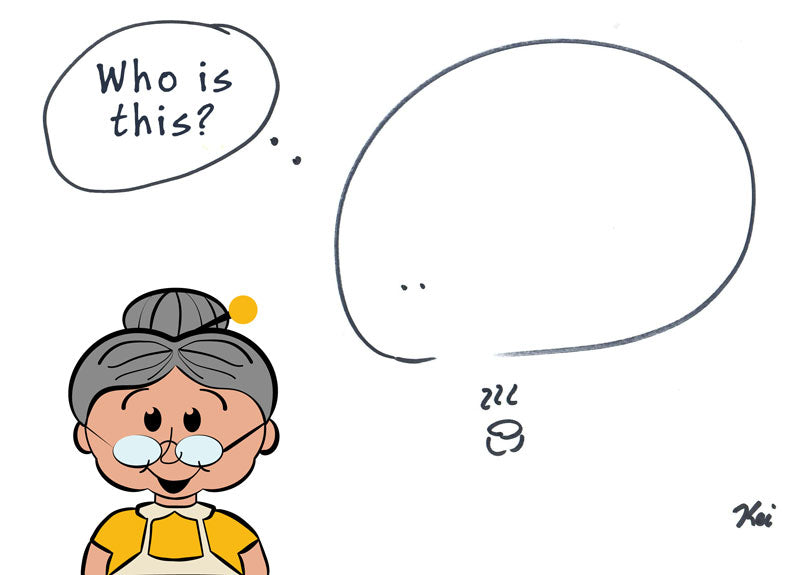Characters
Kei – the boy (Junior High Age): A male student who loves all things green tea. While he is most familiar with modern adaptations of Japanese tea such as match latte, green tea cake, green tea chocolate, and even bubble tea, he is very interested in the rich tradition of Japanese tea and the culture behind it.
Obāchan: This is ChaCha’s grandmother. She is old and wise and knows all about the history of Japanese Tea. She is very happy that young people like Kei are still interested in tea, and she enjoys teaching them about traditional tea. Likewise, she is fascinated by all the new types of tea and is always happy to learn from the younger generation.
Set 1: An old washitsu-style room
Kei comes home from school excited about a new drink
K: Tadaima, I’m home from school!
O: Okairinasai! What took you so long? Usually, you are home an hour ago… did you stop somewhere on your way home?
K: Sorry about that, Obāchan. Some friends and I stopped off at Starbucks after class. They have this new green tea Frapachino and we just had to try it!
O: A green tea what-achino?
K: A green tea frapapichino. It’s a new type of drink where you take green tea, blend it with milk, sugar, and ice to make it almost like a milkshake! Then to top it all off, you squirt on some sweet whipped cream and drizzle it with green tea syrup!
It’s all the rage with young people these days! You’ve got to try it!
O: Oh my! You call that green tea? That sounds nothing like the green tea back from when I was a girl.
K: The green tea from when you were a girl?
O: Yes, back in my day, green tea was exactly what it was. Green tea!
K: I love green tea but even you can admit, that sounds a little boring don’t you think?
O: Anything but! Green tea has a long and rich history stretching back to even the days of the samurai you know.
K: The samurai?
O: Yes, let me tell you now a little bit about how the samurai perfected the art of the tea ceremony and how tea culture became an integral part of what it means to be a Samurai warrior.

Set 2: An Edo style castle
O: The samurai were a fierce group of Japanese warriors that became the ruling military class during the Edo period. Samurai were sworn to protect their feudal lords and lived by a strict set of moral codes called bushido. This bushido code was “the way of the warrior” and in order to become a true warrior of the bushido code, samurai had to undergo all sorts of strenuous and intense training.
K: Oh! We learned about this in school! I heard that sometimes samurai would practice with their swords for hours every day without rest. And that some samurai would sit perfectly still under punding waterfalls in the middle of the winter to strengthen test the limits of their bodies!
O: That’s right Kei.
K: But I still don’t understand, what has all of this got to do with green tea?
O: You see, being a samurai was equal parts physical as it was mental. Just as a samurai had to sharpen his blade every day and hone his technique, it was just as important for him to sharpen his mind as well.
K: Sharpen his mind?
O: Yes. You see, the Japanese tea ceremony is much more than pouring tea into a cup.
K: It is?
O: Yes. In fact, it takes years and years to learn how to do a proper tea ceremony, and there are some individuals that even dedicate their entire lives to mastering the art form.
K: I had no idea!
O: I didn’t think so. Young people these days rarely know about these things but I am very happy that you’ve taken an interest.
K: Please tell me more!
O: The tea ceremony has many delicate elements that require exact precision, hence it takes much dedication and mental energy in order to execute it well.
K: Like what?

O: For example, cultivating the charcoals for the fire. In order to get the tea to simmer at the exact right temperature, the correct ratio of charcoal and fodder must be achieved. In addition, the size and intensity of the fire must be just right. A one-degree difference in temperature can completely alter and manipulate the taste of the tea.
K: Really? It’s hard to imagine that such a foundational step would have so much of an impact!
O: Yes, that’s right. Another example is with steeping the tea. Tea masters have to know exactly how long to let the tea steep before pouring and serving the guests. Just like the fire, this is a very delicate matter. If you wait one second too long, the tea can be too strong, leaving a very bitter taste. One second too fast and your tea will be too weak and not at all enjoyable.
K: And this is before they had battery-operated timers and so they had to do all of the counting inside their heads right?
O: Exactly! It really is quite impressive the more you think about it!
K: So how did all this help the samurai in battle? After all, they were the greatest and most powerful warriors in all of Japan, weren’t they?
O: I’m getting there, don’t you worry.
Japanese tea ceremony requires perfect mental clarity in your mind in order to perform properly. As you know about the cultivation of the fire and the pouring of the tea, even the slightest hesitation before you act can cause a fatal error that can completely ruin the batch of tea. Ruin the tea, and your guest’s overall experience will be ruined as well. In other words, you are not just responsible for yourself, but for everyone at the table.
K: I’m starting to see how this all comes together.
O: I’m so glad to hear that you’re getting it. The tea ceremony mimics the battlefield. If the Samurai warrior hesitates during battle, it could mean the difference between life or death. Think too much and your reactions will be slowed. The samurai’s mind must act in perfect unison with his body to achieve victory not just for himself, but also for the master that he serves.
K: This is so cool! I’m wondering though when did the samurai practice the tea ceremony? Was there any particular time?
O: Samurai would often practice tea ceremonies before and after a battle. Doing it before the battle would allow them to relax and clear their minds before going into battle. If they were victorious, at the end of the battle they would also once more conduct a tea ceremony to set their minds at ease as without doubt, they had seen many gruesome and horrible things during the fight.
K: I can imagine being a samurai was a very tough life… I would want a nice hot cup of green tea after I had gone through all of that.

Set 3: An old washitsu-style room
O: So you see, while today a simple cup of green tea may not seem like much, green tea has a history going back hundreds of years in Japan and has been a significant part of Japanese history.
K: Thank you so much for telling me all of this! I really had no idea! I had always seen tea ceremony as something of a frilly hobby that old people practiced but it’s so cool that it was such a big part of samurai culture! It really makes me appreciate green tea more now!
O: I’m so glad that you have taken an interest.
K: Actually, I was wondering where I can learn more about tea and Japanese tea culture?
O: I’m so glad you asked! My granddaughter, Cha-cha, has a Youtube Chanel here. They talk all about different ways you can enjoy Japanese tea, the culture behind it, and even share some recipes of so that you can try it for yourself!
K: Oh!?
O: Yes, if you’d like to learn more, give their channel a follow, and don’t forget to like and subscribe for more!
K: Will do!
O: Thank you so much for joining us today and I’m looking forward to telling you more stories about the history and traditions of the Japanese green tea real soon.
O and K: Bye!
Behind the scene Story about this Video
Can I share a little behind-the-scenes story?
When we published the History of Japanese Green Tea video, someone very close to me said...
It’s boring..
("thud" sound effect goes here)
We spent a lot of effort researching to make the video (you can watch it here), and I believe it is a masterpiece and the only video teaching green tea history in a simple timeline.
She thinks it is like reading a school textbook. Sigh…
I’m like, How can I present accurate and important tea and Japanese culture information without boring people?
Then I remembered about the Yukkuri Kaisetsu series in Japan. Do you know? It’s two animated characters talking in a video.
I got an idea from it and created two characters.
What do you think about the characters we came up with?
I hope it is not boring… and I hope the video teaches something good, a piece of Japanese history.
Let me know what you think, and please give me more "thud" sounds to push me forward!
Thank you very much for your constant support.
With love and gratitude,
Kei
Get Free Bonus Books

Sign up for free to the Green Tea Club to get advice and exclusive articles about how to choose Japanese Tea, and tips, tricks, and recipes for enjoying Japanese tea.
About the author
Kei Nishida
Author, CEO Dream of Japan
Certification: PMP, BS in Computer Science
Education: Western Washington University
Kei Nishida is a Japanese green tea enthusiast, a writer, and the founder and CEO of Japanese Green Tea Co., a Dream of Japan Company. His passion for introducing America to the tea of his homeland was the catalyst for creating the only company that brings high-quality tea from Arahataen Green Tea Farms to the rest of the world. Learn more about Kei
























